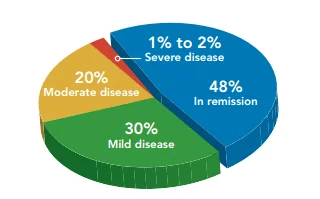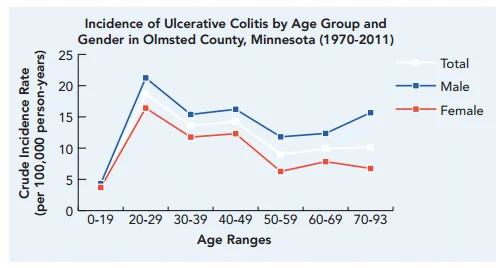Ulcerative Colitis, is an illness that affects a significant portion of the American population. Due to the large percentage of those whom are affected with either non-severe, moderate or severe levels of this illness, this piece aims to discuss three main facets of the topic.
The former will be used to demonstrate what is Ulcerative Colitis and the exact nature of this sickness. The latter will be used to discuss the staggering national as well as global Ulcerative Colitis statistics of this sickness. Finally, this piece will conclude with how you can prevent, aid or completely removal of theUlcerative Colitis’s symptoms.
Ulcerative Colitis Explained
What exactly is Ulcerative Colitis? Well, It is a form of inflammatory bowel disease (IBD). It is one of two forms of IBD, one being Ulcerative Colitis and the other one being Crohn’s disease. Ulcerative Colitis however, typically only affects the large intestines (lining of colon) and one’s rectum, during which this part of your system becomes very inflamed and colon ulcers start to develop.
The exact cause or origin of this Ulcerative Colitis is unknown, however, it is suspected to be triggered by an immune system malfunction. This is when one’s immune system tries to defend an invading virus or bacteria, which then leads to an abnormal immune response by which the immune system attacks the cells within the individual’s own digestive system.
Other possible causes of this sickness are Bacterial or viral infections, one’s environment, ethnicity, food sensitivity and allergies as well as one’s hereditary background. The typical symptoms of this illness typically involve cramping, diarrhea with blood, and swelling of the body’s bowel.
During which it is strongly recommended, one goes and sees their doctor, and immediately eliminate intake of antibiotics, the contraceptive pill, increase intake of foods with high soluble fiber and reduce stress levels.
Read our more in-depth post about Ulcerative Colitis.
Ulcerative Colitis Statistics
While Ulcerative Colitis itself may be less common than other diseases, it affects a significant amount of people both domestically and worldwide. It has been shown to be of greater prevalence in the northern countries and among more affluent regions, which some suspect is due to their diets, lifestyles and environmental surroundings.
In America alone, a reported of 1.6 million people have either Ulcerative Colitis or Crohn’s disease and as many as 70,000 cases of IBD are issued every year. 48% of those diagnosed or found with this illness are in remission (few or even no symptoms), 30% have mild disease activity, 20% have moderate disease activity and 1% to 2% have severe cases of Ulcerative Colitis.
Once one has been diagnosed or found with the Ulcerative Colitis, changes of the illness activity are likely to occur and alter over time, symptoms can often persist and various complications related to the sickness can develop. However, due to the many different forms of Ulcerative Colitis, symptoms often vary and they can also change in severity. It has been reported that approximately

Once one has been diagnosed or found with the Ulcerative Colitis, changes of the illness activity are likely to occur and alter over time, symptoms can often persist and various complications related to the sickness can develop. However, due to the many different forms of Ulcerative Colitis, symptoms often vary and they can also change in severity.
It has been reported that approximately 70% of patients who have active Ulcerative Colitis in one particular year are likely to experience another episode of the illness in the following year. This however, depends on one’s circumstances.
For example, those in remission, around 30% will have active disease the following year while those whom remain in remission longer are less likely to experience the active illness the subsequent year.
It has been shown that the demographics of an individual can also affect their likelihood of being diagnosed with this disease. For example, a study led from 1940 to 2011 in Olmsted County, Minnesota, examined the incidence of IBD. Based on the results and data of this study, the demographics and characteristics of those with the disease were analyzed.
For example, while IBD, more specifically Crohn’s and Ulcerative Colitis disease can occur at any stage of an individual life, it has been proven that this sickness was more common among people of age between 15 and 35. The study also concluded that while this disease was equally common among men and women, it concluded that in the northern countries, the sickness was increasingly likely to be contracted by men aged beyond 50 years of age.
The study also established that while any racial or ethnic group can be affected with a disease as such, Asians were more prone to this sickness at later stages than life relative to other ethnic groups such as African American, Caucasians and Hispanics. It also recognized that Caucasians had a higher family history of IBD, whereas those of a Jewish background were as much as four times less likely to develop this disease.
From a global perspective, these statistics and conclusions slightly differ. Studies have shown an annual incidence of Ulcerative Colitis ranging from 0.5 to 24.5 cases per 100,000 people. It has an apparently affected both men and women equally, and also it is more likely to occur in Northern Europe and Northern America.
While the disease is starting to somewhat settle and stabilize in these continents, there have been an increasing number of reported cases of IBD disease growing in Asian countries and in Southern European.
Treating Ulcerative Colitis
Why the existence of a disease as such is unfortunate and understandably quite frustrating, there are a number of ways to improve one’s condition or even completely eliminate it. If an individual is suffering from non-severe Ulcerative Colitis particularly at the rear end of the colon, there are a number of topical creams, such as a Corticosteroid Enema, available to treat these areas.
Other forms of treatment include prescribed medication such as B12 and iron shots in attempt to compensate for the loss of blood or Glucocorticoids, which, due to it’s anti-inflammatory properties, acts to negate the inflammatory symptoms of the illness (long-term usage is not recommended.) However if one is a victim of severe IBD, they sometimes recommended undertaking surgery in order to partially or completely remove the colon, which my doing so one will remove or significantly minimize all the symptoms of this sickness.
This disease affects many people, and for those who don’t have the disease, there are a number of ways to prevent this illness. While experiencing stress is natural for all human beings, it is recommended to try and control one’s stress levels. It has also been recommended for people to ensure they integrate a healthy amount of omega 3 into their diets, and studies have shown to try and reduce the amount of optional hours one has to spend outdoors.
Read my post on how I overcame my Ulcerative Colitis with tricks and diet.
Sources
- http://www.ccfa.org/assets/pdfs/updatedibdfactbook.pdf
- http://www.vitalhealthzone.com/health/conditions/u/ulcerative-colitis/04_prevention_of_ulcerative_colitis.html
- http://www.mayoclinic.org/diseases-conditions/ulcerative-colitis/basics/causes/con-20043763
- https://en.m.wikipedia.org/wiki/Ulcerative_colitis
- http://www.healthline.com/health/ulcerative-colitis-take-control-can-it-be-cured

